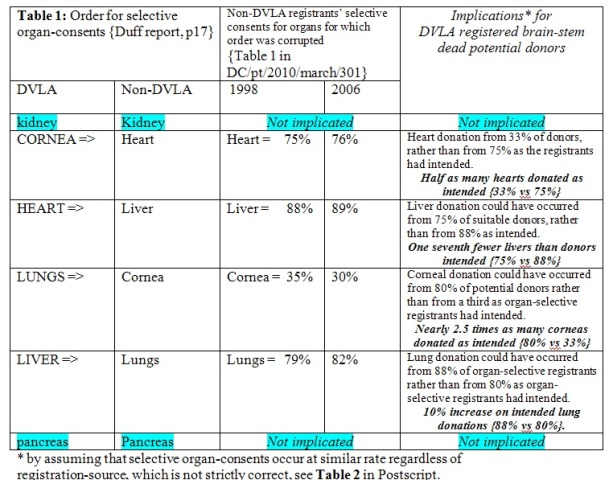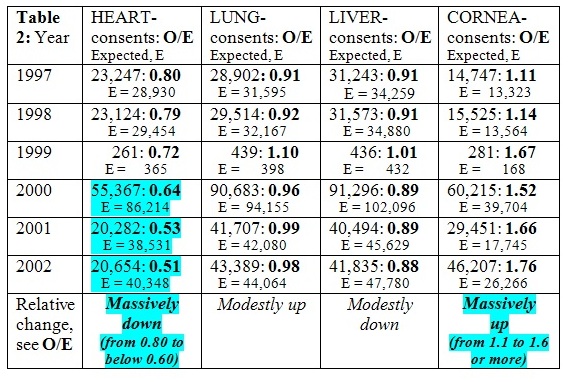Please join the organ donor register: you could save a politician’s life
Sir Gordon Duff’s report on the UK’s organ donor debacle is clear and comprehensive, but characteristically generous in its conclusions.
The truly astonishing fact in his report was that the Organ Donor Register (ODR) – which now has 17 million names on it – was never meant to be an operational tool. Its task was simply to monitor the success of awareness-raising campaigns: a spin-generator rather than a functional tool. When was the public ever told this?
The register’s origin in the world of political PR is an underlying reason why more than ten years ago consents for organ donation were wrongly recorded, an error that went undetected until 2009. The register had not been taken sufficiently seriously, properly analysed, or put to much use save publicity until after 2004 - although millions of people were encouraged to add their names to it in the belief that doing so would have real results.
This is not wisdom after the event: I wrote repeatedly to ministers asking for the ODR to be analysed, with no success.
When the ODR did become an operation tool, rigorous analysis reports still did not ensue. As a result, a coding corruption that dated from 1999 went undetected for 10 years, and some - thankfully few - organs were taken from people who, in life, had specifically said they did not want to donate them, and their next-of-kin were misled. In addition, it seems likely that, in other cases, hearts were not taken from those who, in life, had expressed a willingness to donate.
When Sir Gordon’s review was set up, it was already known that an error in 1999 by UK Transplant - now known as the Organ Donation and Transplantation Directorate (ODT) of NHS Blood and Transplant - had corrupted the consents given by potential donors who had chosen to give some, but not all, organs by registering on the ODR via the Driver Vehicle Licensing Agency (DVLA).
The first consequence was that 25 donor families had to be contacted who, over a period of 10 years, had authorised the donation of organs that the deceased had said they didn’t want to donate. But two other consequences – the failure to retrieve donor-authorised organs, hearts in particular, and the failure to analyse the ODR properly - should not be overlooked.
The ODR was set up in 1994. The main recruiting agent is the DVLA which, by providing the opportunity on its forms for donors to volunteer for the ODR, accounts for nearly half the registrations. The vast majority of DVLA-registrants generously offer ‘all organs’, but 13 per cent make selective consents, agreeing that after their death some organs, but not all, can be taken for transplantation.
It is these selective donations where the error originated in1999 when ODT was migrating operations to a new computer and the programmer was unaware, and would not have expected (!), that organ-specific permissions were listed in a different order for DVLA compared to other registrants: see Table 1.
Corrupted permissions for nearly a million DVLA-registrants had to be corrected, most programmatically (see => in Table 1). This still necessitated writing to some 300,000 individuals for reasons that don’t follow directly from the described corruption unless they included DVLA-registrants who had put X against ‘all organs’ and also X against one or more selected-organs. This combination of Xs is illogical, and so needs verification, because on the DVLA forms X is used to signify assent (not refusal)!
Sir Gordon’s report provides little detail on which organs may have been transplanted despite the wish of the deceased that they should not be. Table 1 allows an approximation to be made. UK has had some 6,000 brain-stem dead donors in the past 10 years. About a fifth would have been ODR-registered via DVLA because public willingness is 60 per cent vs 25 per cent who register willingness, of whom 8 out of 17 registered via DVLA. (That is: I’m hazarding that 25/60 x 6,000 donors would have been ODR-registered, of whom 8/17 would have registered via DVLA.) Of the latter, approximately 1,200 brain-stem dead DVLA-registered donors, an eighth would have had a corrupted record of permissions: about 150 brain-stem dead donor families over 10 years.
Of these 150 families, contrary lung donation may have occurred for 8 per cent (see Table 1: 88 per cent - 80 per cent) of donors with suitable lungs, that is for 8 per cent x 40 per cent (lung suitability) x 150 = 5. Contrary corneal donation may have occurred for 47 per cent of donors with suitable corneas for whom donation was actively considered (less often than corneal suitability might suggest), and so for perhaps 47 per cent x 1/3 (considered and suitable) x 150 = 24 families. My very approximate calculations (this level of detail was not provided in the Duff report) explain why only 25 families had to be contacted to explain that a donation may have been made that the deceased had selected against. Most families were reassured by the generous decisions that they had made.
No contact was made with those donor families whose deceased relative had been willing for liver donation but, due to corrupted permissions, the family may have been advised otherwise. My very approximate calculations suggest around 13 per cent (see Table 1: 88 per cent – 75 per cent) x liver suitability (around 80 per cent) x 150 = 16 families.
Or, where the heart had been offered but the family may have been advised otherwise – 42 per cent x heart suitability (around 2/3) x 150 = 42 families. When overlap between liver/heart families, relatives’ right to over-rule the deceased’s permissions, and historically lower organ-specific permissions by DVLA-registrands (see Postscript: 20 per cent lower for hearts, 10 per cent for livers) are taken into account, corrupted permissions may have compromised some 40 transplants over 10 years – relatively few, but precious nonetheless to those who awaited this gift of life. The actual count was not provided in Sir Gordon Duff’s report.

Some other registration-routes into ODR than DVLA allow a single option only: ‘all organs’. How such operational differences were ever permitted on a national organ donor registry beggars belief until one reads the truly unbelievable – that the ODR was set up not with the intention that it be consulted to establish if a potential brain-stem dead donor was among the growing millions of named, identifiable, altruistic individuals who had registered their intentions on ODR but merely to monitor the impact of the then-government’s publicity campaigns to encourage donation. The more names listed when publicity campaigns ran, the better the campaign!
Those named individuals who registered their donation-intentions on the ODR did so for them to be heeded, not for public relations. Ministers and officials who were party to this abuse of public trust should be ashamed. Put at risk for PR and politics was the outstanding reputation of the transplantation community for rigorous analysis.
NHS ODR was under-analysed, a matter on which I wrote to Ministers in the late 1990s. But I never for a moment imagined that consulting the ODR to search for a potential donor’s wishes did not even begin to become routine until 2004.
In 2008, the Organ Donor Taskforce failed to call for a thorough analysis of NHS ODR, a missed opportunity. Sir Gordon now recommends how to strengthen NHS ODR and that secure public access to it be arranged, at inevitably much higher cost.
He does not question whether, if there is to be registration, opt-out should now replace opt-in. ‘Authorisation’ for donation was a key issue for the Organ Donor Taskforce. At the recent debate on ‘Paying for blood and organs is not so bad . . . ‘ - under the auspices of the Centre for the Study of Incentives in Health and hosted at the Wellcome Collection Conference Centre on 11 October 2010 – I argued against the motion but reminded the audience of the tremendous NHS value represented by the altruism of a brain-stem dead potential donor: at least 10 quality-adjusted life-years, or £200,000.
Would relatives be less inclined to refuse authorisation for transplantation if they had to pay inheritance tax on the £200,000 value of organs lost through a refusal of authorisation? The UK has at most 1,000 brain-stem dead potential donors a year. Only these few, if the deceased had opted-out in life or if the family declined authorisation, might incur additional inheritance liability if, in death, they chose not to give life.
Why then do we maintain, at growing cost and – as is now evident – some risk, a named register of over 17 million names, addresses, sex, date of birth? If we are to maintain it, rigorous, publicly-reported annual analyses will be essential; and substantial investment.
Conflict of interest: I declare my long-standing opposition to opt-in registers which under-represent the public’s willingness to donate. In October 1999, in a letter to Lord Hunt, then parliamentary under-secretary with responsibility for transplantation, I wrote: “Registration of 8 million people when Gallup surveys year-on-year, and my own research, have shown that 70 per cent of the UK population is willing to donate kidneys is NOT, I suggest, a success story. Moreover, if 14 per cent of UK population is correctly registered on NHS Organ Donor Register, why were only 78 kidneys retrieved from donors whose names were included on ODR when in 1998 there were 1,372 cadaveric kidney transplants: 78/1372 = 5.7 per cent?” That question remained unanswered when the correspondence was closed in August 2000. Mea culpa.
Postscript: Background papers linked to Sir Gordon Duff’s report reveal that, had there been a thorough annual statistical report on NHS ODR (as for other, non-politicised aspects of transplantation statistics), then the transposition of DVLA-registered permissions would have been obvious in 2000 and 2001.
Table 2 {based on Table 2 in background paper DC/pt/2010/march/301}compares DVLA organ-specific consents (O) versus expectations (E) based on other-sourced ODR-registrations via their ratio(O/E). In O/E relative terms, DVLA-heart permissions dropped massively from 1999 and corneal permissions increased massively. The former, had it been monitored, would certainly have set off alarm bells as heart-beating brain-stem dead donors are the only source of hearts for transplantation.

Sheila M. Bird is at the MRC Biostatistics Unit, CAMBRIDGE CB2 0SR



